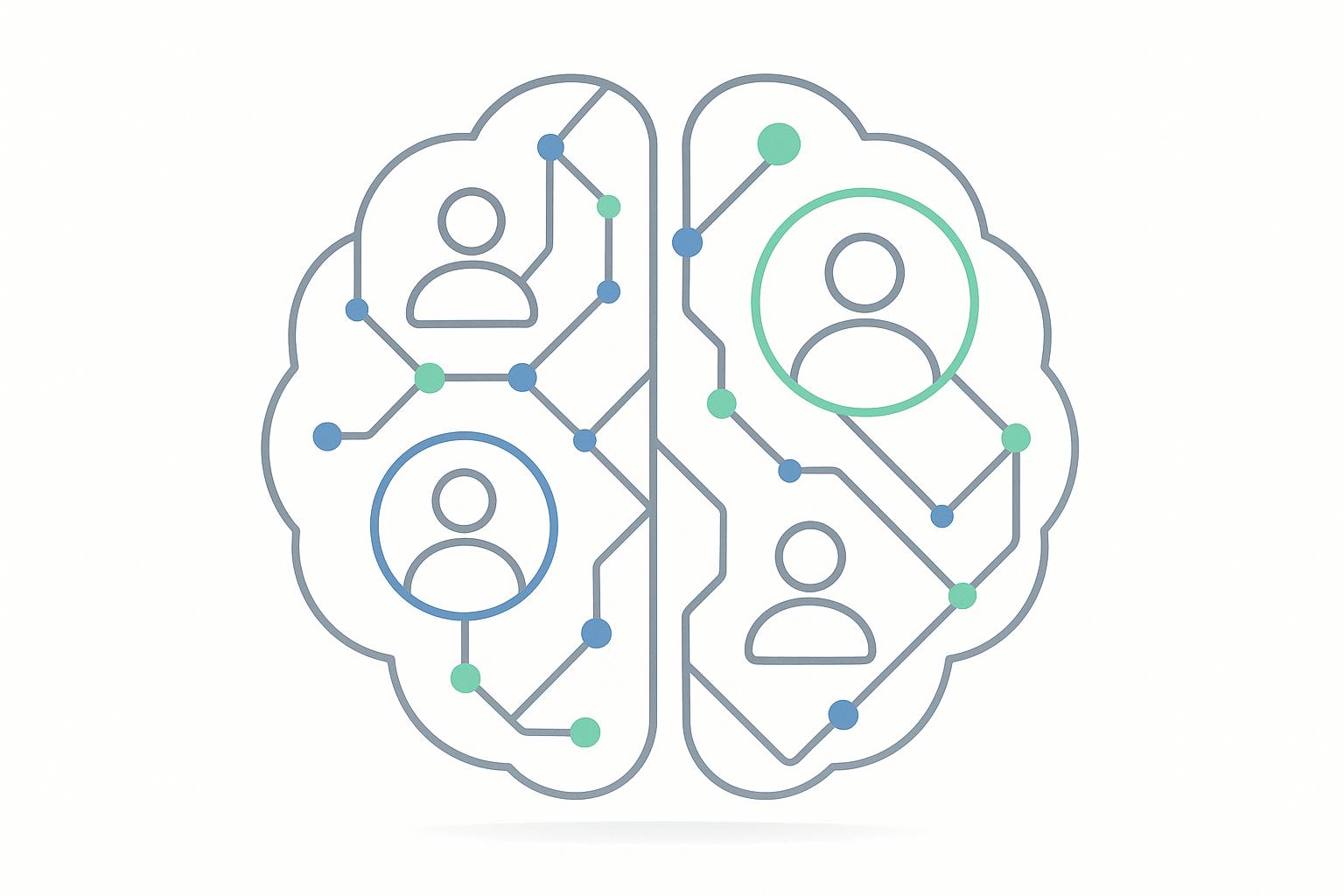AI is changing how we analyze stock markets by focusing on investor psychology and market trends. Here's what you need to know:
- AI's Role: It processes vast data - like trading patterns, social media sentiment, and news - to predict market behavior.
- Key Benefits for Startups and SMBs: Advanced tools, like Lucid Financials, make financial planning and risk analysis easier and more accessible.
- Behavioral Patterns: AI identifies cognitive biases (e.g., loss aversion, overconfidence) and group behaviors (e.g., herd mentality) that influence market trends.
- AI Techniques:
- Machine Learning: Detects unusual trading patterns.
- NLP: Analyzes sentiment from news and social media.
- Deep Learning: Predicts price movements using historical and real-time data.
- Challenges: Data quality, ethical concerns, and regulatory compliance must be addressed for reliable and fair AI use.
AI tools are making market analysis faster and more precise, helping businesses make smarter decisions and stay ahead of market changes.
Key Behavioral Patterns in Stock Markets
Investor Cognitive Biases
Investor behavior often follows certain predictable patterns due to cognitive biases. For example, loss aversion leads investors to overreact to losses, while confirmation bias causes them to seek out information that supports their existing beliefs. These tendencies can influence market trends in noticeable ways.
Overconfidence is another common bias that can result in:
- Too much trading during market peaks
- Poor diversification strategies
- Taking on unnecessary risks
- Delayed responses to market downturns
While individual biases play a role, the collective behavior of investors has an even greater impact on overall market patterns.
Group Psychology in Markets
Group behavior in markets often revolves around fear and greed, driving trends like spikes in trading volumes or sudden shifts in price momentum. One example is herd mentality, where investors follow the crowd instead of relying on detailed analysis. This behavior can lead to:
- Momentum-driven trading
- The creation of market bubbles
- Rapid shifts between sectors
- Exaggerated reactions to major news
A clear example of this was the market downturn in March 2020, when panic selling caused a surge in volatility. This was reflected in the VIX index hitting record highs.
AI tools are particularly effective at identifying these behavioral patterns. By analyzing multiple data sources simultaneously, such as:
- Changes in trading volumes
- Price momentum trends
- Sentiment on social media
- News cycles
- Activity in the options market
AI can uncover insights that help explain and predict market movements.
Quant Radio: How AI Reads Market Moods to Predict Stock ...
AI Methods in Stock Market Analysis
AI is reshaping how we analyze stock market behavior by using specialized techniques to uncover and predict market trends.
Pattern Detection with Machine Learning
Machine learning algorithms dive into vast amounts of historical data to spot patterns in trading volumes, price movements, and order flows. They can flag unusual activity, like irregular trading volumes, price spikes, or coordinated trades, which may suggest market manipulation. This ability to recognize patterns is a key step in understanding market behavior.
Market Sentiment Analysis with NLP
Natural Language Processing (NLP) tools turn unstructured text into useful market insights. These tools scan financial news, social media, earnings calls, SEC filings, and analyst reports to extract sentiment signals. By processing massive amounts of text quickly, they help identify shifts in market mood that could influence prices. When combined with deep learning, these insights are merged with numerical data to improve price predictions.
Price Prediction with Deep Learning
Deep learning models take historical prices, sentiment data, technical indicators, and macroeconomic trends to predict market movements. They are particularly good at spotting volatility spikes, trend changes, and setting price targets. These models continuously learn and adjust, making them effective at blending behavioral insights with technical data to keep up with changing market conditions.
sbb-itb-17e8ec9
AI Applications in Market Analysis
AI is reshaping market analysis by using advanced techniques to identify patterns and predict trends. It can process massive amounts of data to detect unusual behaviors, helping traders and businesses identify potential opportunities or risks in the market.
Spotting Market Irregularities
AI tools are built to identify shifts and deviations in market behavior. Some of their key abilities include:
- Volume anomalies: Detecting unusual trading volumes that may indicate upcoming price changes.
- Price pattern breaks: Recognizing disruptions in price trends that could signal market shifts.
- Sentiment changes: Monitoring sudden shifts in public or investor sentiment that influence valuations.
- Correlation breakdowns: Identifying when typical relationships between markets or assets start to diverge, hinting at potential instability.
These tools allow for more informed and accurate decisions. For example, Lucid Financials uses AI-powered anomaly detection to convert raw data into insights tailored for startups and small businesses.
Risks and Ethics in AI Market Analysis
AI offers valuable tools for analyzing stock market behavior, but it also comes with risks and ethical challenges that require careful management. Effective oversight is key to balancing these capabilities with responsibility.
Data Quality Challenges
The accuracy of AI-driven stock market analysis heavily depends on the quality of the data it uses. Poor data can lead to various problems, including:
- Bias in Data: Historical market data often reflects outdated conditions, which may not align with current market realities.
- Incomplete Data: Gaps or missing information can result in flawed predictions.
- Noise in the Data: Random, irrelevant fluctuations in market data can mislead AI into identifying patterns that don't exist.
To address these issues, organizations should:
- Set up strong data validation processes
- Use multiple trustworthy data sources
- Regularly audit AI outputs for accuracy
- Clearly document any data limitations or gaps
Maintaining high-quality data is essential for meeting both legal and ethical standards in AI-driven market analysis.
Legal and Ethical Considerations
AI applications in market analysis must meet regulatory standards and address ethical concerns. Key regulatory requirements include:
- Transparency: AI decisions should be explainable, with clear records of how conclusions are reached.
- Fair Trading Practices: Measures like speed limits on automated trading can help prevent unfair advantages.
- Data Privacy: Sensitive information must be protected through strict data handling protocols.
- Market Manipulation Prevention: Systems should be monitored to ensure they don't artificially influence prices.
Ethics are equally important in this context. Some key considerations are:
- Fairness: AI systems should not disadvantage smaller market participants.
- Accountability: Organizations must take responsibility for decisions made by AI systems.
- Human Oversight: Regular human reviews of AI outputs are necessary to ensure reliability.
- Market Stability: The broader impact of AI-driven actions on market stability should always be considered.
Financial institutions need clear governance structures to manage these challenges. These often include:
- Ethical audits of AI systems
- Detailed documentation of decision-making processes
- Protocols for managing system errors
- Training programs for employees using AI tools
At Lucid Financials, we prioritize strong data governance and ethical oversight to ensure our AI-driven market analysis is both reliable and transparent.
What's Next for AI in Market Analysis
Emerging AI Technologies
AI is transforming how businesses analyze markets, making predictions more precise and actionable. Key developments include:
- Improved Natural Language Processing (NLP) and Real-Time Recognition: AI tools are now better at analyzing market news, social media sentiment, and financial reports. They can identify patterns and anomalies almost instantly.
- Advanced Predictive Analytics: By merging historical data with live market signals, these tools provide more accurate forecasts.
These advancements are paving the way for businesses to adopt AI tools more effectively.
Preparing for AI Tools
Adopting AI-driven market analysis tools requires thoughtful preparation. Here’s how businesses can get ready:
-
Evaluate and Plan
Review your current financial processes to pinpoint areas where AI can make a difference. Consider factors like data quality, team expertise, and specific business goals. -
Choose and Implement Tools
Select tools that align with your needs and capabilities. For instance, Lucid Financials offers features like quick financial planning, scenario analysis, benchmarking, and real-time insights - ideal for startups and small businesses. -
Train Your Team
Equip your team with the skills needed to use AI tools effectively. This ensures they can fully leverage the technology for market analysis.
To get the most out of AI tools, businesses should focus on:
- Keeping data accurate and up-to-date
- Regularly evaluating system performance
- Staying informed about new AI features
- Applying insights to strategic decisions
Conclusion
Key Takeaways
AI is reshaping stock market analysis by uncovering market trends and understanding investor behavior. Major advancements include machine learning for identifying patterns, natural language processing (NLP) for analyzing sentiment, and deep learning for predicting prices. These tools have made high-level market analysis accessible to businesses of all sizes.
AI integration in market analysis offers clear benefits such as:
- Reducing biases in decision-making
- Spotting market trends early
- Analyzing data from multiple sources
- Generating actionable insights
These improvements make the implementation process more efficient and effective.
Steps to Implement AI in Market Analysis
1. Evaluate and Plan
Start by reviewing your current market analysis capabilities, data sources, and team expertise. Set clear budget limits and identify areas for improvement.
2. Choose and Integrate Tools
Select AI tools that provide real-time data analysis, automated pattern recognition, and scenario planning. Ensure they work seamlessly with your existing systems, prioritize security, and establish clear performance benchmarks.
3. Optimize and Adapt
Regularly review the system's performance, update team training, fine-tune AI parameters, and adjust strategies based on the insights generated.


